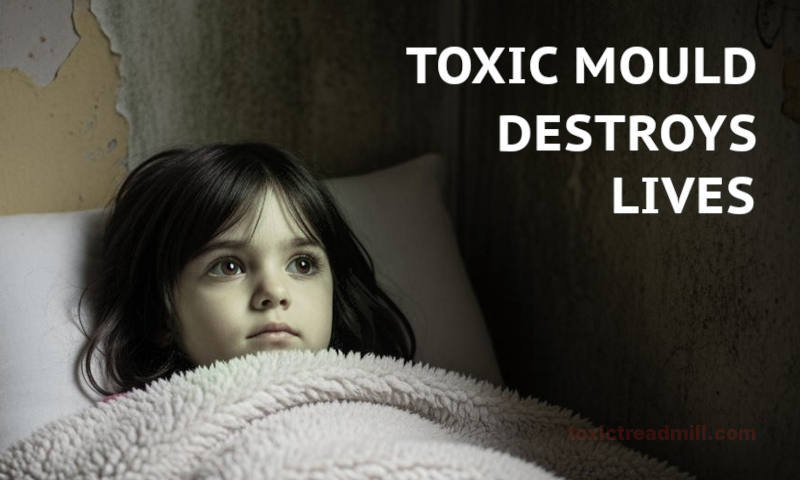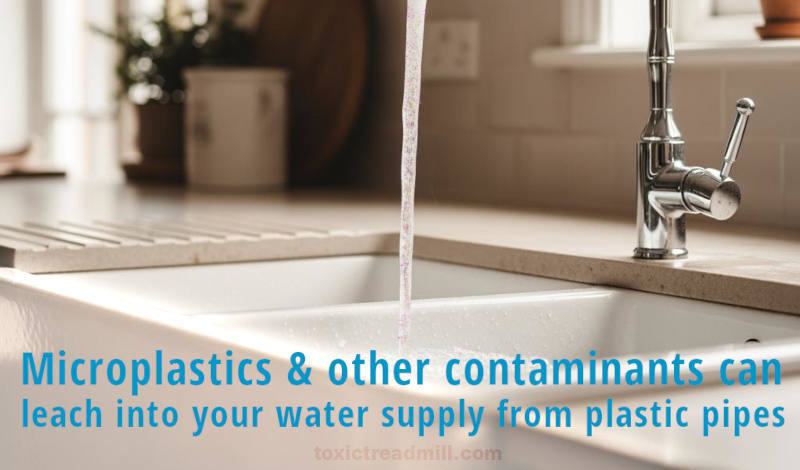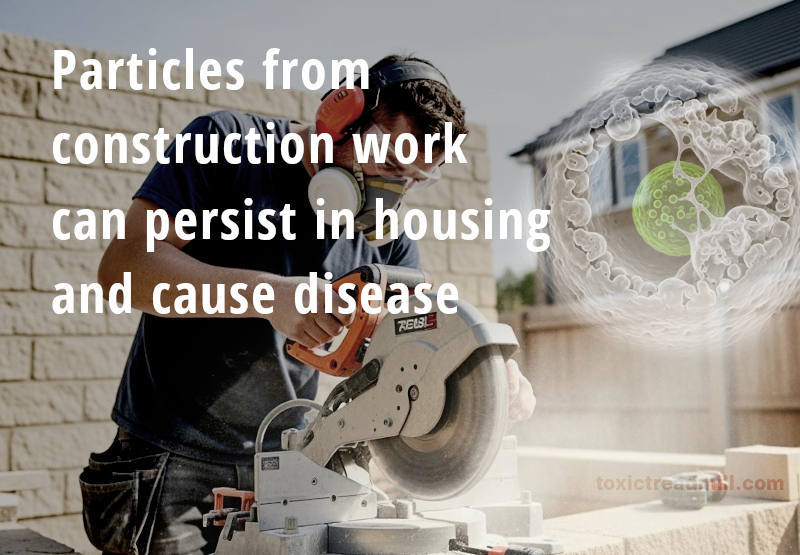Toxic Treadmill
Evidence for a Poisoned Planet
Housing Hazards and Health Harms
Globally, poor quality housing is recognized as a significant public health concern due to its role as a determinant of numerous toxic exposures affecting respiratory and general health. In temperate climates, particularly in the UK where dampness and mould growth are common, inadequate heating, poor ventilation, and structural deterioration compound these hazards and contribute to elevated rates of asthma, allergies, and other respiratory conditions. The unique interplay between building design, maintenance practices, and cost-cutting has led to environments where hazardous exposures such as black mould, dust mites, and toxic substances from degraded building materials are routine. Evidence from numerous clinical trials further supports the notion that housing improvements can lead to measurable health benefits, emphasizing the necessity for integrative approaches that address the multifactorial origins of exposure.
Biological Hazards
Biological hazards in poor quality housing primarily arise from excessive dampness and moisture, conditions that foster the growth of moulds, bacteria, and dust mites, all of which have been strongly linked to respiratory pathologies. Damp environments provide a conducive setting for the proliferation of toxic moulds, including black mould species such as Stachybotrys chartarum, which release mycotoxins and microbial volatile organic compounds (MVOCs) that impair lung function and exacerbate asthma symptoms. In addition to mould growth, high indoor humidity levels facilitate the survival and multiplication of house dust mites that release potent allergens capable of triggering allergic rhinitis and asthma episodes in sensitized individuals. Moreover, indoor air enriched with fungal spores and bacterial contaminants, invisible to the eye, has been associated with the development of hypersensitivity pneumonitis and other respiratory complaints among vulnerable populations such as children and the elderly. The significance of these biological hazards is underscored by studies that demonstrate the reduction in acute care visits following effective mould remediation interventions. As such, biological contaminants represent a clear nexus between poor housing conditions and increased respiratory morbidity worldwide.

Beyond mould and dust mites, other biological agents such as cockroach allergens and pet dander have been identified as noteworthy contributors to the indoor allergen burden in substandard homes. Persistent exposure to these allergens, especially in overcrowded dwellings with inadequate cleaning and poor ventilation, can trigger chronic inflammation and sensitization, leading to conditions such as asthma and eczema. The interrelationship between biological contaminants and indoor air quality is further complicated by the fact that dampness not only supports microbial growth but also contributes to the accumulation of particulate matter and other airborne allergens. Strengthening building design with effective moisture control and regular maintenance can therefore play a crucial role in minimizing exposure to these pervasive biological hazards.
Chemical Hazards from Building Materials
Chemical exposures in poor quality housing are largely attributed to the deterioration, or improper use, of building materials. Over time, they release toxic substances into the indoor environment. Materials such as lead-based pipework, plastic pipework, cement, bricks, and wood are of particular concern. They can harbour contaminants and leach chemicals when subjected to degradation under conditions of high humidity or water damage. For instance, old lead-based paint or contaminated dust from lead pipework can contribute to cumulative lead exposure. This is known to affect neurodevelopment in children, and cause a range of systemic health issues.

Plastic pipework is commonplace, and often assumed to be inert. However, studies have shown that numerous contaminants are leached into the water supply from plastic pipes and rubber seals, including microplastics, poly aromatic hydrocarbons, and plasticizers. Some substances are leached due to the presence of disinfecting agents; for example, the chlorine in chlorinated water. Unforeseen effects of this pollution include the creation of an ecosystem favourable to pathogenic microbes, and dysbiosis of the human microbiome. Additionally, the microbes in plastic pipes tend to form biofilms, which in turn can accumulate heavy metals including lead, and other toxins, with potential for later release into potable water. These issues tend to be more severe in pipework subject to higher temperatures, freeze-thaw cycles, and those with low usage.
Off-gassing of volatile chemicals from treated wood and building materials has been linked to respiratory irritation and other toxic effects in both adults and children. They can be the source of volatile organic compounds (VOCs) (including formaldehyde, benzene, and ketones), radon, and other toxicants, that contribute to a broader spectrum of indoor pollution. The presence of these pollutants is exacerbated by poor building practices, where cost-cutting measures may lead to the use of substandard materials that fail to meet safety guidelines.
Novel additives, such as nanoparticle injection or coating, has also been deployed to increase water resistance and durability to inert materials such as stone. However, few have been subject to rigorous, long-term safety testing, and some are proving potentially hazardous with capacity to enter the body, antagonize the immune system, and disrupt cellular metabolism.

In addition to in-use hazards, building material waste and dust can also affect health, both as a byproduct of construction processes, and following replacement or demolition. Many of the toxic chemicals that derive from construction and housing materials have no aroma and are invisible. However, they cause a range of health harms including mucus membrane irritation, asthma, headaches, skin disease, fatigue, endocrine disruption, and cancer.
Poor Ventilation and the Consequences for Indoor Air Quality
Inadequate ventilation is a cardinal feature of poor quality housing and contributes dramatically to the concentration of indoor toxicants and allergens. Homes with deficient ventilation systems tend to trap moisture, leading to condensation, dampness, and subsequent mould growth, alongside the accumulation of indoor pollutants. This stagnation of indoor air exacerbates the health impacts of chemical and biological exposures, increasing the risk of respiratory infections, allergies, and even chronic obstructive pulmonary disease (COPD). Interventions aimed at improving ventilation can yield significant health benefits by reducing indoor toxicants, humidity and, consequently, the proliferation of dust mites and mould. Importantly, the benefits of ventilation will be mediated by the quality of the air outside.
Dust, Dust Mites, & Indoor Aggregates
Dust accumulation in poorly maintained housing is a common issue that acts as a reservoir for a multitude of allergens and toxicants. Dust in such environments often contains a mixture of particulate matter, microbial fragments, chemical residues, and biological allergens, including dust mite faeces. The presence of dust mites is especially problematic in homes with high humidity and inadequate cleaning practices, where their proliferation is promoted. Failing to clean thoroughly amplifies the allergenic load and exacerbates health conditions like rhinitis and asthma. Insufficient ventilation compounds this problem. Such harmful situations are too common in substandard housing managed by negligent landlords, or resulting from cost-cutting practices. Dust left to settle on surfaces, or penetrate into fabrics, may attract and transport hazardous chemicals including residues from degraded building materials. Health can be damaged as a consequence.
Given that dust accumulation can act as an early indicator of broader maintenance problems within a housing unit, regular cleaning routines and proactive indoor environmental assessments are critical to reduce exposure. The interplay between dust, allergens, and trapped moisture underscores the complex nature of indoor exposures in poor quality housing, necessitating coordinated efforts to address both the sources and the pathways of exposure.

Fraud, Cost-Cutting, and Lack of Maintenance
A recurrent theme in the literature on poor quality housing is the role of cost-cutting, fraudulent construction practices, and neglectful landlord maintenance in precipitating hazardous environments. In many cases, efforts to reduce construction and repair costs lead to the use of inferior building materials and suboptimal construction techniques. In turn, the resulting structures rapidly deteriorate and are prone to moisture intrusion. This decline in structural quality often precipitates a cascade of hazards, including dampness, mould proliferation, and the release of toxic substances from compromised materials. Landlords who fail to adhere to maintenance protocols, or who deliberately postpone necessary repairs, directly contribute to the persistence of these environmental hazards. They are responsible for putting tenants at continuous risk. The combination of fraudulent practices and cost-cutting not only undermines the overall quality of the housing stock, but also creates systemic issues whereby occupants, particularly in low-income communities, are forced to live in hazardous conditions with limited recourse.
Global Perspectives & Focus on Temperate Climates
While poor quality housing represents an issue of global concern, the manifestation of its health hazards is particularly acute in temperate climates, such as those in the United Kingdom. In such regions, residents frequently contend with high indoor relative humidity, condensation, and thermal bridging, all of which contribute to the persistent emergence of damp environments. The incidence of mould, including toxic varieties like black mould, is notably higher in the UK, where climatic conditions exacerbate moisture retention in building envelopes that are often not adequately insulated or maintained. Moreover, older housing stocks, common in the UK, frequently incorporate building materials that are prone to chemical degradation and consequent toxic exposures, such as lead-based paints, contaminated pipework, and treated wood.
International comparisons suggest that, while many high-income countries have implemented policies to mitigate such hazards, gaps remain in enforcement and remediation efforts, particularly where cost-cutting measures and fraudulent construction practices persist. Furthermore, research indicates that social inequalities compound the negative impact of poor housing quality in temperate climates, with vulnerable populations—such as low-income families and ethnic minorities—disproportionately affected by persistent dampness, inadequate ventilation, and chemical exposures.
The UK has taken small steps to address these issues through measures such as improved housing codes and inspection protocols; nonetheless, the prevalence of substandard housing remains a major contributor to respiratory and systemic health problems. Cross-national efforts and community-based interventions have underscored that improvements in housing quality can lead to significant reductions in hospital admissions and improved quality of life for affected residents.
Intervention Strategies & Policy Implications
Given the broad spectrum of health hazards associated with poor quality housing, a multifaceted approach is required to mitigate both biological and chemical exposures. Persuasive evidence suggests that home-based environmental interventions can lead to appreciable improvements in indoor air quality and reductions in asthma exacerbations among children. These interventions typically involve the installation of HEPA-filtered equipment, the use of hypoallergenic bedding, and the application of non-toxic cleaning agents to reduce exposure to allergens and toxicants. In addition, the introduction of mechanical ventilation systems has demonstrated noteworthy improvements in reducing indoor humidity and dust mite populations.
Interventions must also address the systemic issues related to cost-cutting measures and landlord neglect. Policy initiatives that enforce stringent building codes, mandate regular inspections, and hold landlords accountable for maintenance lapses can help to mitigate the chronic exposures that arise from substandard housing. Furthermore, community-based programs can effectively reduce exposure to housing-related asthma triggers while simultaneously advocating for tenant rights through discussions with landlords regarding building code violations. They can also encourage parents and guardians not to neglect their children's health, highlighting the importance of proper ventilation, regular and thorough vacuuming, and dust removal.
Summary
Poor quality housing constitutes a significant global health hazard, particularly in temperate climates such as the UK. The convergence of biological hazards (such as toxic moulds, dust mites, and microbial contaminants) with chemical exposures (including degraded building materials and inadequate ventilation systems), creates an environment that predisposes residents to a host of respiratory and allergic diseases. These can contribute to, or cause, chronic illness, disability, and death. Systemic issues of cost-cutting, fraudulent construction practices, tenant and landlord neglect, further compound these risks.
References
AlSuhaimi, A. O., Fantoukh, A. A., AlHarbi, E. A., & Shaikh, M. M. (2025). Occurrence of volatile organic contaminants in tap water due to the use of plastic plumbing pipes. Water SA, 51(1), 11-17.
Beheshti, R., Phipatanakul, W., DiMango, E., & Grant, T. L. (2025). Indoor allergen interventions in homes and schools for managing asthma. The Journal of Allergy and Clinical Immunology: In Practice.
Braubach, M., Jacobs, D. E., & Ormandy, D. (2011). Environmental burden of disease associated with inadequate housing. World Health Organization.
Brooks, S. K., Patel, S. S., Weston, D., & Greenberg, N. (2025). Psychological effects of mould and damp in the home: scoping review. Housing studies, 40(2), 323-345.
Coulburn, L., & Miller, W. (2022). Prevalence, risk factors and impacts related to mould-affected housing: an Australian integrative review. International Journal of Environmental Research and Public Health, 19(3), 1854.
Du, C., Li, B., & Yu, W. (2021). Indoor mould exposure: characteristics, influences and corresponding associations with built environment—a review. Journal of Building Engineering, 35, 101983.
Fadel, H. A. (2022). Contamination from plastic pipes in small systems: migration and leaching. Applied Water Science, 12(9), 231.
Fisk, W. J. (2018). How home ventilation rates affect health: A literature review. Indoor air, 28(4), 473-487.
Gulzar, A., Hassan, T., & Gulzar, R. (2022). Potentially toxic construction materials: An introduction. Ecological and health effects of building materials, 1-11.
Holden, K. A., Lee, A. R., Hawcutt, D. B., & Sinha, I. P. (2023). The impact of poor housing and indoor air quality on respiratory health in children. Breathe, 19(2).
Howieson, S. G., Lawson, A., McSharry, C., Morris, G., McKenzie, E., & Jackson, J. (2003). Domestic ventilation rates, indoor humidity and dust mite allergens: are our homes causing the asthma pandemic?. Building Services Engineering Research and Technology, 24(3), 137-147.
Ige, J., Pilkington, P., Orme, J., Williams, B., Prestwood, E., Black, D., ... & Scally, G. (2019). The relationship between buildings and health: a systematic review. Journal of public health, 41(2), e121-e132.
Kim, J. T., & Yu, C. W. (2014). Hazardous materials in buildings. Indoor and Built Environment, 23(1), 44-61.
Krieger, J., & Jacobs, D. E. (2011). Healthy homes. Making Healthy Places: Designing and Building for Health, Well-Being, and Sustainability, 170-187.
Krieger, J., Jacobs, D. E., Ashley, P. J., Baeder, A., Chew, G. L., Dearborn, D., ... & Zeldin, D. C. (2010). Housing interventions and control of asthma-related indoor biologic agents: a review of the evidence. Journal of Public Health Management and Practice, 16(5), S11-S20.
Kua, K. P. (2023). Better health through better housing–Current impact and future prospects of randomized trials. Contemporary Clinical Trials, 127, 107114.
Kubba, S. (2015). Indoor environmental quality (IEQ). LEED v4 Practices, Certification, and Accreditation Handbook, 303.
Mohammadi, A., Dobaradaran, S., Schmidt, T. C., Malakootian, M., & Spitz, J. (2022). Emerging contaminants migration from pipes used in drinking water distribution systems: a review of the scientific literature. Environmental Science and Pollution Research, 29(50), 75134-75160.
Ortiz, M., Itard, L., & Bluyssen, P. M. (2020). Indoor environmental quality related risk factors with energy-efficient retrofitting of housing: A literature review. Energy and Buildings, 221, 110102.
Pelto-Huikko, A., Ahonen, M., Ruismäki, M., Kaunisto, T., & Latva, M. (2021). Migration of volatile organic compounds (VOCs) from PEX-a pipes into the drinking water during the first five years of use. Materials, 14(4), 746.
Remzova, M., Zouzelka, R., Brzicova, T., Vrbova, K., Pinkas, D., Rőssner, P., ... & Rathousky, J. (2019). Toxicity of TiO2, ZnO, and SiO2 nanoparticles in human lung cells: safe-by-design development of construction materials. Nanomaterials, 9(7), 968.
Sarigiannis, D. A., Gotti, A., & Karakitsios, S. P. (2019). Indoor air and public health. In Management of emerging public health issues and risks (pp. 3-29). Academic Press.
Sharpe, R. A., Taylor, T., Fleming, L. E., Morrissey, K., Morris, G., & Wigglesworth, R. (2018). Making the case for “whole system” approaches: Integrating public health and housing. International journal of environmental research and public health, 15(11), 2345.
Sharpe, R., Thornton, C. R., & Osborne, N. J. (2014). Modifiable factors governing indoor fungal diversity and risk of asthma. Clinical & Experimental Allergy, 44(5), 631-641.
Singh, J., Yu, C. W. F., & Kim, J. T. (2010). Building pathology, investigation of sick buildings—toxic moulds. Indoor and Built Environment, 19(1), 40-47.
Świetlik, J., & Magnucka, M. (2025). Aging of drinking water transmission pipes during long-term operation as a potential source of nano-and microplastics. International Journal of Hygiene and Environmental Health, 263, 114467.
Tulchinsky, T. H., & Varavikova, E. A. (2014). Environmental and occupational health. The new public health, 471.
Vojta, P. J., Friedman, W., Marker, D. A., Clickner, R., Rogers, J. W., Viet, S. M., ... & Zeldin, D. C. (2002). First National Survey of Lead and Allergens in Housing: survey design and methods for the allergen and endotoxin components. Environmental Health Perspectives, 110(5), 527-532.
Weitzman, M., Baten, A., Rosenthal, D. G., Hoshino, R., Tohn, E., & Jacobs, D. E. (2013). Housing and child health. Current problems in pediatric and adolescent health care, 43(8), 187-224.
Xie, S. (2024). Study on chemical pollution in building decoration materials. Academic Journal of Environment & Earth Science, 6(6), 33-38.
Yang, X., Zhou, Y., Xia, R., Liao, J., Liu, J., & Yu, P. (2024). Microplastics and chemical leachates from plastic pipes are associated with increased virulence and antimicrobial resistance potential of drinking water microbial communities. Journal of Hazardous Materials, 463, 132900.